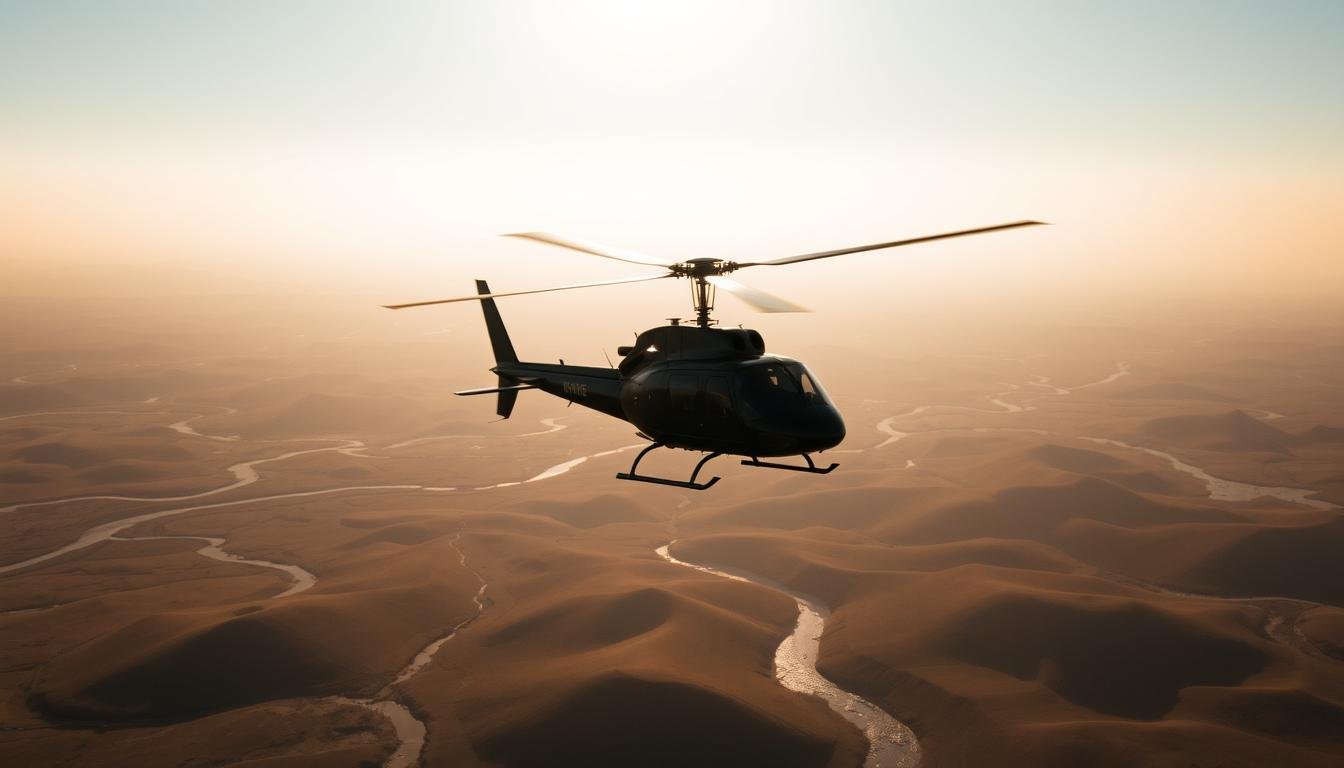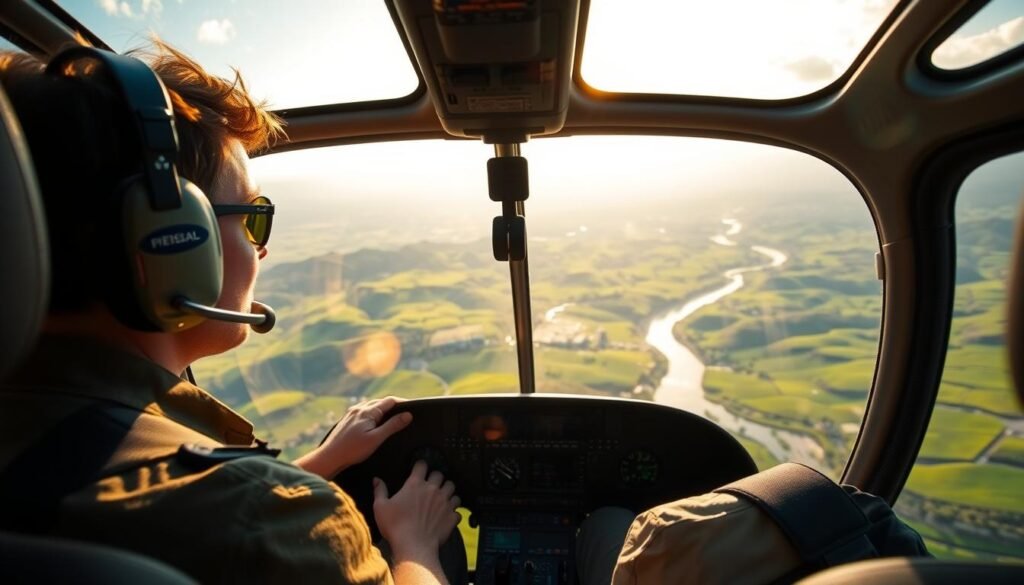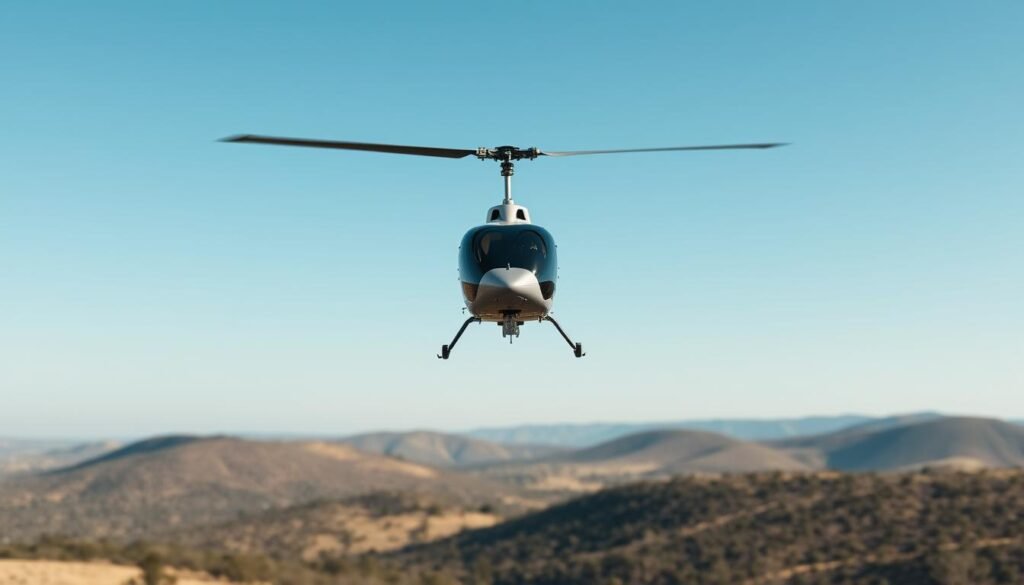What really sets the limit on a helicopter’s single‑tank mission: design specs or real‑world conditions?
This introduction frames a practical answer by describing typical single‑tank range and the reasons that number varies. Most rotorcraft average roughly 250–500 miles on a tank, with piston models often near 200–350 miles and turbine types commonly about 300–450 miles.
The piece explains why hovering burns more fuel than forward flight and why mission profile, weight, and weather shift endurance. It notes typical operating altitudes near 5,000–7,500 feet and special missions that go higher, with record climbs reaching extreme heights.
Rather than rely on brochure numbers, readers will learn to treat range as a dynamic envelope shaped by fuel planning, reserves, power settings, and air traffic limits. The guide previews model examples and real mission profiles that separate myths from operational reality in modern aviation.
Key Takeaways
- Single‑tank range usually spans about 200–500 miles depending on engine and mission.
- Hovering uses significantly more fuel than efficient forward flight.
- Weight, weather, and power settings are key factors that alter effective range.
- Altitude and oxygen needs matter for high‑altitude operations.
- Practical planning beats brochure specs when estimating distance and endurance.
Understanding Helicopter Flight Range Today
Helicopter flight range is best viewed as an operational envelope, not a fixed number. Factory specs show ideal miles per tank, but pilots plan with conservative figures that account for reserves and alternate routing.
Typical single‑tank ranges center near 250–450 miles for many civil types. Piston models most often record about 200–350 miles, while turbine types typically reach 300–450 miles under calm conditions.
Performance shifts with payload, winds, and routing. Density altitude, temperature, and headwinds increase fuel burn and reduce usable range. Improvements in engine efficiency and rotor design, however, have nudged practical miles upward in recent models.
Pilots balance mission needs against mandatory reserves. That conservative planning explains why operational numbers often fall short of brochure maximums. Airframe design and rotor systems also change drag and lift, affecting cruise speed and overall range.
| Type | Typical Range (miles) | Usual Altitude (ft) |
|---|---|---|
| Piston | 200–350 | 5,000–7,500 |
| Turbine | 300–450 | 5,000–10,000+ |
| Civil Average | 250–450 | 5,000–7,500 |
- Practical planning wins over brochure claims.
- Routing, timing, and climb/cruise profiles define dependable miles.
How Far Can Helicopters Travel?
Real-world single‑tank performance depends on mission choices more than brochure numbers. Pilots plan with reserves, payload limits, and expected winds to set a conservative operational envelope.

Typical Single-Tank Range: 250-450 Miles In Practice
Many rotary aircraft record between 250 and 450 miles on a single tank in routine mission profiles. Piston models most often sit near 200–350 miles, while turbine types commonly reach 300–450 miles under calm conditions.
Those figures assume cruise flight with normal payload and standard reserves rather than maximum-range tests.
What Pushes The Limits: Records, Tiltrotors, And Refueling
Exceptional flights have exceeded 1,000 km and special installs add auxiliary tanks for long legs. Tiltrotor demonstrators such as the Bell V-280 show much greater range than conventional types.
In‑flight refueling and ferry configurations create boundary cases, but they are not representative of routine flight planning.
Speed And Altitude Context: From 5,000-14,000 Feet To Extreme Ceilings
Typical operations occur between 5,000 and 7,500 feet, with capable models reaching 10,000–14,000 feet. Higher altitude increases power demand and affects fuel burn; supplemental oxygen is often required near the top end.
Speed, power setting, and altitude combine to determine usable range more than any single headline number.
How To Plan And Calculate Real-World Helicopter Range
Pilots begin range planning by converting onboard fuel into conservative endurance, then layering in reserves and alternates.

Start With Fuel: Tank Capacity, Reserves, And Burn Rates
First, list total gallons on board by tank layout. A Robinson R44 holds about 31.6 gallons main plus an ~18.5‑gallon auxiliary. A Bell 206 totals near 98 gallons across main and forward tanks. Heavy types like the Mil Mi‑26 may hold thousands of gallons.
Next, use published burn rates to convert gallons to minutes. Add mandatory reserves and a contingency margin to protect safety.
Balance Payload: Passengers, Cargo, And Weight Tradeoffs
Adding payload raises weight and reduces efficiency. Pilots should compute payload vs fuel tradeoffs to keep the planned distance achievable.
Account For Weather And Altitude: Winds, Density Altitude, And Routes
Forecast winds aloft, temperature, and density altitude change power needs and can significantly increase fuel usage.
Choose An Efficient Profile: Cruise Speed, Hover Time, And Detours
Prefer cruise profiles that minimize hover and unnecessary low‑speed flight. Factor climbs, holds, and expected detours into the fuel math.
- Rule: Fuel in minus expected burn minus reserves = usable endurance.
- Translate endurance into distance using planned cruise speed and routing.
- Brief crew on stops and alternates so expectations match real capability.
Key Factors That Affect Range: Fuel, Payload, Weather, And Design
Range hinges on a cluster of practical elements, from fuel layout to weather and aircraft design. Pilots weigh these factors before every mission to set realistic margins and maintain safety.
Fuel Capacity And Tank Layout: Main, Auxiliary, And Extra Fuel Tanks
Tank configuration shapes endurance. Small types like the R44 use main plus auxiliary tanks, medium types such as the Bell 206 hold about 98 gallons, and heavy frames like the Mil Mi-26 approach ~3,200 gallons.
Strategic placement improves balance and fuel management when operators add auxiliary or external fuel tanks.
Engine Type And Efficiency: Piston Versus Turbine
Piston platforms usually record 200–350 miles; turbine types commonly reach 300–450 miles. Turbines offer higher efficiency at cruise and better range in many mission profiles.
Payload And Weight Management: Passengers, Gear, And Cargo
Added payload and weight reduce range quickly. External lift machines like the Kaman K-MAX handle ~6,000 lb, while the Sikorsky S-64 can lift up to 25,000 lb—tradeoffs in fuel and handling matter.
Altitude And Air Density: Practical Ceilings And Oxygen Needs
Typical operations center on 5,000–7,500 feet. Higher altitude raises power demand and may require oxygen near 14,000 feet, which affects range and performance.
Weather Conditions: Headwinds, Tailwinds, And Storm Avoidance
Weather alters usable range: headwinds shorten legs, tailwinds extend them, and convective conditions force reroutes that increase fuel use.
Aerodynamics And Model Design: Rotor Systems, Drag, And Materials
Design choices—from rotor efficiency to airframe drag and composite materials—improve fuel efficiency and extend practical range over time.
For a practical comparison of common civil models and their range traits, see a concise model guide at top civilian helicopters.
Models, Missions, And Example Ranges
This section compares familiar models to show realistic mission distances and typical operational range for civil, rescue, heavy‑lift, and military operations.
Civil And Charter Examples
Civil platforms like the Robinson R44 and Airbus H125 serve many charter routes and short shuttles.
The R44 typically manages about 350–400 miles on a tank. The H125 usually records near 340–345 miles, making both solid choices for passenger and light cargo legs.
Medical And Rescue Profiles
EMS and search rescue missions prioritize equipment and speed over maximal distance.
Models such as the AS‑350 B3 often show ranges near 345 miles in ferry profiles but operational legs are shorter due to hoists, med kits, and staging.
Heavy Lift And Construction
S-64 Skycrane and K‑MAX specialize in lift, not long legs.
The S‑64 lifts up to about 25,000 lb while the K‑MAX handles near 6,000 lb. Payload focus and frequent cycles limit practical distances despite decent fuel capacity.
Military Helicopters
Military aircraft often extend mission reach with external tanks or refueling.
Examples: CH‑47 Chinook roughly 400–450 miles, UH‑60 Black Hawk about 360–370 miles, Bell UH‑1 near 300–315 miles, and Mil Mi‑8 around 280–310 miles. Specialized flights and in‑flight refueling create exceptions, not the rule.
| Model | Typical Example Range (miles) | Primary Mission |
|---|---|---|
| Robinson R44 | 350–400 | Civil charter, shuttle |
| Airbus H125 | 340–345 | Charter, utility |
| AS‑350 B3 | ~345 (ferry) | EMS, search rescue |
| S‑64 Skycrane | Operationally limited by payload | Heavy lift, construction |
| Boeing CH‑47 Chinook | 400–450 | Military transport, long‑range moves |
Practical note: Route choice, terrain, cabin load, and mission profile (hover, sling, cruise) change usable miles more than brochure maxima. For a broader planning guide, see this internal reference on overall helicopter range.
Ways To Extend Range Safely And Efficiently
Extending a helicopter’s flight range requires careful tradeoffs between added fuel, weight, and safety margins. Pilots and operators choose tactics that preserve reserves while gaining practical miles.
Auxiliary Tanks And External Tanks: When To Add Fuel
Auxiliary and external fuel tanks provide clear benefits on long legs when payload and balance allow. Operators fit them for ferry flights or crossing sparse areas where alternates are few.
Adding tanks increases weight and changes center of gravity. Crews must recalculate takeoff limits, hover performance, and emergency procedures to keep safety intact.
Optimized Routing And Pre-Flight Planning
Modern navigation and weather services help pilots choose routes that reduce detours and avoid adverse weather conditions. Smart routing often saves more fuel than minor airframe changes.
Pre‑flight planning should list alternates, reserve requirements, and realistic speeds to keep the planned flight range predictable.
Reducing Drag And Weight For Better Efficiency
Simple steps improve efficiency: remove unnecessary gear, secure external loads, and streamline pods or racks. Less drag means less fuel burned for the same miles.
Payload discipline is often the highest‑value tactic to extend range without adding tanks.
Emerging Tech: Powerplants, Avionics, And Future Possibilities
New engines, lighter materials, and advanced avionics incrementally boost efficiency across fleets. Larger platforms such as the CH‑53K advertise extended range in ferry configs, but most gains remain evolutionary today.
| Technique | Benefit | Operational Note |
|---|---|---|
| Auxiliary/External Fuel Tanks | Increase usable range | Requires weight/balance checks and revised safety procedures |
| Optimized Routing | Reduces unnecessary miles and detours | Relies on up‑to‑date winds and terrain data |
| Drag & Weight Reduction | Improves cruise efficiency | Focus on payload discipline and load streamlining |
| Advanced Avionics & Engines | Incremental range gains | Promising over time; limited fleet penetration now |
Checklist: Verify tanks, compute revised fuel, choose cruise speed that balances time and economy, select altitudes to reduce power demand, and brief crew on emergency and refueling options. These steps help pilots safely add practical range while protecting reserves and mission safety.
Conclusion
A clear planning mindset treats range as an adjustable envelope shaped by fuel, payload, and weather.
Pilots and operators should expect a few hundred miles per tank in routine flight. Specific model, tank layout, and weight decide whether a leg is nearer 250 or 450 miles.
For longer flight range, crews add auxiliary tanks, enforce payload discipline, and pick efficient climb and cruise profiles so safety reserves remain intact.
Mission type matters: search rescue, charter, construction, and military operations each change usable distance, speed, and altitude needs.
Practical design gains in rotors, drag reduction, and engines slowly improve efficiency. For a concise review of range myths and practical planning, see this range guide.
FAQ
How far can helicopters fly on a single tank under normal conditions?
Typical single-tank range for many light and medium helicopters is about 250–450 miles. That reflects cruise speed, fuel burn, and required reserves. Models such as the Robinson R44 usually sit near the lower end, while turbine types like the Airbus H125 reach the higher end. Pilots always plan with legal fuel reserves and alternate airports in mind.
What factors most affect a helicopter’s flight distance?
Key influences include tank capacity, fuel burn rate, payload weight, altitude, and wind. Weather and density altitude change engine efficiency and lift. Aerodynamic design, rotor system, and whether auxiliary or external tanks are installed also alter effective range.
Can auxiliary or external fuel tanks increase operational range?
Yes. Auxiliary tanks extend endurance and mission radius for search and rescue, offshore transport, or ferry flights. Approval from the aircraft manufacturer and compliance with weight-and-balance limits and certification rules are required before adding extra tanks.
How do payload and passengers affect distance?
Additional weight raises fuel consumption and reduces ceiling ability, which shortens practical range. Operators balance passengers, cargo, and fuel to keep the helicopter within performance limits while meeting mission needs.
Do weather and winds change how far a helicopter will go?
Strong headwinds reduce ground distance for a given fuel load; tailwinds increase it. Turbulence, icing, and thunderstorms force route deviations or higher fuel reserves. Pilots plan routes and contingencies to manage these variables safely.
What are typical ceiling and altitude effects on range?
Many civil helicopters operate between 5,000 and 14,000 feet. Higher altitudes reduce air density, cutting engine power and rotor efficiency and increasing fuel burn for the same performance. Some turbine designs perform better at altitude than piston-powered aircraft.
Are there record long-distance helicopter flights or special cases?
Yes. Ferry flights, tiltrotor aircraft like the Bell Boeing V-22 Osprey, and specially outfitted helicopters have completed very long legs using auxiliary tanks and in-flight refueling in military contexts. Those examples require specialized planning, equipment, and certification.
How do engine types compare for efficiency and range?
Piston engines are common in light helicopters and are economical for short missions. Turbine engines offer higher power-to-weight ratios and better high-altitude performance, often yielding longer practical range in similar-sized airframes despite higher fuel flow.
What planning steps determine realistic route distance?
Pilots calculate usable fuel, burn rates, reserves, alternate airports, and expected winds. They incorporate weight-and-balance, terrain clearance, weather forecasts, and airspace restrictions. Flight planning tools and performance charts guide the final decision.
Can military helicopters refuel in flight to extend range?
Many military rotorcraft, such as variants of the CH-47 Chinook, support aerial refueling, greatly extending mission duration and reach. In-flight refueling requires specific receivers and trained crews and is not available for most civil helicopters.
What role do aerodynamics and rotor design play in maximum range?
Rotor efficiency, airframe drag, and materials affect power required to cruise. Advanced rotor designs and streamlined fuselages lower fuel burn. Design choices that reduce parasite and profile drag improve overall endurance.
How do operators increase efficiency without adding fuel tanks?
Operators optimize cruise speed, reduce unnecessary payload, plan direct routes with favorable winds, and limit hover time. Regular maintenance to keep engines and rotors at peak performance also preserves fuel efficiency.
Which helicopter models illustrate common range categories?
Light piston types like the Robinson R44 have ranges near 250–300 miles. Single-engine turbine models such as the Airbus H125 often reach 300–450 miles. Heavy-lift platforms like the Sikorsky S-64 Skycrane prioritize payload over maximum distance but can carry auxiliary tanks for ferry flights.
How does altitude affect safety and oxygen requirements during long flights?
Operating at high altitudes can require supplemental oxygen for crew and passengers and changes in engine performance. Pilots follow regulations for physiological needs and plan routes to avoid extended exposure to altitudes above service ceilings without proper equipment.
What emerging technologies may improve future helicopter range?
Advances in hybrid-electric propulsion, lighter composite materials, improved avionics for optimized routing, and higher-efficiency turbines promise better specific fuel consumption and longer mission endurance in coming years.capable of covering long distances safely and efficiently.
Related Articles
- Can Anyone Learn to Fly a Helicopter? Understanding Training and Skills Required
- Why Do Helicopters Make That Distinctive Sound? Helicopter Noise Explained
- Do Helicopters Require More Maintenance Than Airplanes? Separating Fact from Fiction
- How Far Can Helicopters Travel? Dispelling Range Myths
- What Happens if a Helicopter Engine Fails? Debunking Catastrophe Myths
More from This Category
- Are Helicopters More Dangerous Than Planes? A Safety Comparison
- Do Helicopters Have Parachutes? Exploring Emergency Systems
- Can Helicopters Fly Upside Down? The Truth Behind Aerobatic Stunts
- Do Helicopters Need a Runway? Myth vs. Reality
- How Much Does It Really Cost to Fly a Helicopter? Busting the Myths
- How High Can Helicopters Fly? Debunking Altitude Myths
- Can Helicopters Fly in Bad Weather? Understanding Helicopter Capabilities
- Do Helicopters Really Hover Forever? Separating Fact from Fiction
- How Safe Are Helicopters? Debunking Common Misconceptions
- Top 10 Myths About Helicopter Safety: What You Need to Know



